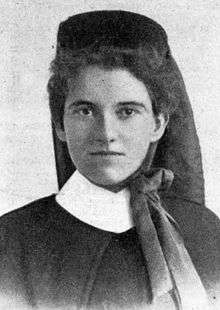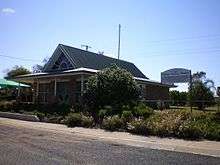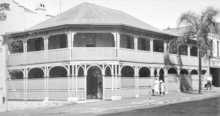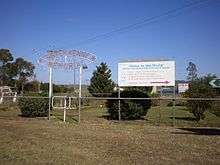Elizabeth Kenny
| Elizabeth Kenny | |
|---|---|
|
Elizabeth Kenny in 1950 | |
| Born |
20 September 1880 Warialda, New South Wales |
| Died | 30 November 1952 (aged 72) |
| Nationality | Australian |
| Other names | Lisa |
| Citizenship | Australian |
| Occupation | Nurse |
Elizabeth Kenny (20 September 1880 – 30 November 1952) was an unaccredited Australian nurse who promoted a controversial new approach to the treatment of poliomyelitis. Her findings ran counter to conventional medical wisdom; they demonstrated the need to exercise muscles affected by polio instead of immobilising them. Kenny's principles of muscle rehabilitation became the foundation of physical therapy, or physiotherapy.[1]
Her life story was told in the 1946 film Sister Kenny. She was portrayed by Rosalind Russell, who was nominated for the Academy Award for Best Actress for her performance as Kenny.
Early life
Elizabeth Kenny was born in Warialda, New South Wales, in 1880[2] or 1886, the daughter of Mary (née Moore), a native Australian, and Michael Kenny, a farmer from Ireland.[3][4] She was called "Lisa" by her family and was home-schooled by her mother before attending schools in New South Wales and Nobby, Queensland. At age 17, she broke her wrist in a fall from a horse. Her father took her to Aeneas McDonnell, a medical doctor in Toowoomba, where she remained during her convalescence. While there, Kenny studied McDonnell's anatomy books and model skeleton. This began a lifelong association with McDonnell, who became her mentor and advisor. Kenny later asserted that she became interested in how muscles worked while convalescing from her accident.[5] Instead of using a model skeleton, since they were available for medical students only, she made her own. From age 18 until her mid-twenties, she worked as an unaccredited bush nurse in the Clifton district.[6] In 1907, Kenny returned to Guyra, New South Wales, to live with a cousin. While there she claimed to receive basic nursing training from a local midwife, but there is no record of her undertaking formal nursing training.[7] She also brokered agricultural sales between Guyra farmers and northern markets in Brisbane. She was not a member of a religious order; in some Commonwealth nations, the title "sister" is applied to senior qualified nurses and does not necessarily indicate a religious vocation.[8]
Work
In 1909, Kenny returned to Nobby and assumed the role of a qualified nurse after paying a tailor to make her a nurse's uniform, complete with cap and cape.[7] Using the money she earned by brokering produce in Guyra, she opened a cottage hospital (St. Canice's) in 1911 at Clifton. Kenny provided convalescent and midwifery services at St. Canice's, and treated her first confirmed cases of infantile paralysis (as polio was also known) under the supervision of the local Lodge Doctor.[7]
Kenny claimed in her 1943 autobiography (co-authored by Martha Ostenso) that she treated her first cases of infantile paralysis in 1910 while working alone as a bush nurse in the Clifton district. That episode was romanticised in the 1946 film Sister Kenny, featuring Rosalind Russell (who befriended Kenny). Surveillance records from the early 1900s show that infantile paralysis was a rare disease in Queensland prior to World War I,[9] although there is evidence that subacute cases were brought to Kenny's cottage hospital in Clifton.[7] In her memoir, Kenny claimed she was baffled by the cases she encountered and sought assurance from Dr. Aeneas McDonnell. He wired back, "...treat them according to the symptoms as they present themselves". Sensing that their muscles were tight, she did what mothers around the world did: applied hot compresses and weights made from woollen blankets to their legs. Kenny wrote in her autobiography that a little girl woke up very much relieved and said, "Please, I want them rags that well my legs". Several children recovered with no serious aftereffects. Many years passed before Kenny treated anyone else who might have had polio.[7] The story of Kenny's first encounter with an acute case of polio is a 20th-century medical legend, but there is no documented record other than her memoir. The chief witness to the discovery of her method for treating poliomyelitis was Aeneas McDonnell, who died before the story was widely publicised.[10]

World War I
In 1915, Kenny volunteered to serve as a nurse in the war.[2] She was not officially qualified, but nurses were badly needed; she was accepted and assigned to "Dark Ships": transports that ran with all lights off between Australia and England carrying war goods and soldiers one way, and wounded soldiers and trade goods on the return voyage. Kenny served on these dangerous missions throughout the war, making sixteen round trips (plus one around the world, via the Panama Canal). In 1917 she earned the title "Sister" (which in the Australian Army Nurse Corps is the equivalent of a first lieutenant), and used that title for the rest of her life. She was criticised by some for doing so (in the British Commonwealth, it was reserved for qualified nurses), but Kenny was officially promoted to that rank during her wartime service. During the final months of the war, she served for a few weeks as matron in a soldiers' hospital near Brisbane and was honourably discharged and qualified for a pension.[10]
Press reports from Australia during the 1930s quote Kenny as saying she developed her method while caring for meningitis patients on troopships during World War I.[11][12]
Return to Queensland

Although exhausted by her war service, Kenny supervised a temporary hospital in Nobby that had been established to care for victims of the 1919 influenza epidemic. When the epidemic subsided, Kenny travelled to Guyra to recuperate (without success) and returned to Europe to visit doctors there. After her return to Nobby, she was called to Guyra by a girlhood friend to care for her daughter (Daphne Cregan), who was disabled with what was known as cerebral diplegia. Kenny's three years of rehabilitative work with the child,[6] plus her experience with sick and wounded men during World War I, are probably the foundation for her later work in polio treatment and rehabilitation. Elizabeth Kenny adopted a daughter called Mary Stewart, who went on to be one of her top researchers.
Instead of settling down at home in what was most expected (a spinsterhood dedicated to caring for her mother) Kenny continued to work as a nurse from her mother's home, often brought to her patients in the sidecar of a motorcycle or by automobile. When a family friend's daughter Sylvia was injured by falling into the path of a horse-drawn plough, the friend called Kenny for help. Kenny improvised a stretcher from a cupboard door, fastened Sylvia to it and accompanied her the 26 miles (42 km) to Dr. McDonnell's Toowoomba office. Sylvia recovered, primarily due to Kenny's careful attention during that transport. Kenny improved the stretcher for use by local ambulance services, and for the next three years, marketed it as the "Sylvia Stretcher" in Australia, Europe and the United States. She turned the profits over to the Australian Country Women's Association, which administered its sales and manufacturing.[6]
Polio treatment

When sales of the Sylvia Stretcher declined, Kenny returned to home nursing. During one of her sales journeys, she met a family who arranged for her to visit their station west of Townsville in 1929 to care for their niece Maude, who was disabled by polio. "At the time the normal medical procedure for dealing with infantile paralysis consisted of immobilising the affected limbs in splints," said Jim Franklin. After 18 months under Kenny's care, Maude was able to walk, return to Townsville, marry and conceive a child. The newspapers in Townsville took up the story, referring to it as a cure. In 1932, Queensland suffered its highest number of polio cases in 30 years; the following year, several local people helped Kenny set up a rudimentary polio-treatment facility under canopies behind the Queens Hotel in Townsville. In a few months (after further success with local children), she moved into the bottom floor of the hotel. The first official evaluation of Sister Kenny's work took place in Townsville in 1934, under the auspices of the Queensland Health Department (QHD). This evaluation of her work led to the establishment of Kenny clinics in several cities in Australia. The Sister Kenny Clinic in the Outpatients Building of the Rockhampton Base Hospital is now listed on the Queensland Heritage Register.[13]

During these years, Kenny developed her clinical method and gained recognition in Australia. She was adamantly opposed to immobilising children's bodies with plaster casts or braces. At this time, Kenny requested that she be permitted to treat children during the acute stage of the disease with hot compresses (as she claimed to have done in Clifton before the war). However, doctors would not allow her to treat patients until after the acute stage of the disease or until "tightness" (Kenny used the word "spasm" much later) subsided. She instituted a carefully designed regimen of passive "exercises", designed to recall function in unaffected neural pathways (much as she had done with Maude). On her own, she began treatment of a patient in the acute stage in her George Street Clinic in Brisbane, then transferring her to the Ward 7 Polio Clinic in Brisbane General Hospital. That child (and others) recovered with fewer aftereffects than those placed in braces. In 1937, she published an introductory book about her work and began another (The Treatment of Infantile Paralysis in The Acute Stage), which was later published in the United States.[14] The most comprehensive appraisal of her methods was published in collaboration with Dr. John Pohl in 1943.[15]
Between 1935 and 1940, Kenny travelled extensively throughout Australia helping to set up clinics. She also made two trips to England, where she set up a treatment clinic in St. Mary's Hospital near Carshalton; a rehabilitation facility still exists there.[6][7] Between 1936 and 1938, a Queensland Government Royal Commission evaluated Kenny's work and published its Report of The Queensland Royal Commission on Modern Methods for the Treatment of Infantile Paralysis in 1938. Its most critical comment (because Sister Kenny opposed using splints and plaster casts to immobilise the areas of polio patients affected by the disease) was, "The abandonment of immobilization is a grievous error and fraught with grave danger, especially in very young patients who cannot co-operate in re-education." They stated that her clinic (then in Brisbane) was "admirable". The Commissioners' strongest objections were against the Queensland government, which was funding Kenny's work when her clinic was not under the purview of the BMA. The Queensland Government rejected the report, continuing to support Kenny's work.[16][17][18]
In the U.S.
In 1940, the New South Wales government sent Kenny (and her adopted daughter Mary, who had become an expert in Kenny's method) to America to present her clinical method for treating polio victims to American doctors. After a sea journey from Sydney to Los Angeles and by railway to San Francisco, Chicago, New York City, back to Chicago and to the Mayo Clinic in Rochester, Minnesota, she was given a chance to demonstrate her work in Minneapolis, Minnesota. Doctors Miland Knapp and John Pohl (who headed polio treatment centres there) were impressed, and told her that she should stay. They found an apartment for Kenny and Mary; several years later, the city of Minneapolis gave them a house. The city was Kenny's base in America for 11 years. In a 1943 letter to the British Medical Journal, Kenny noted that "there have been upwards of 300 doctors attending the classes at the University of Minnesota".[19]
During this time, Kenny treatment centres were opened throughout America; the best-known were the Sister Kenny Institute in Minneapolis (now Courage Kenny Rehabilitation Institute), a facility in the New Jersey Medical Center and her favourite, the Ruth Home in El Monte, California. She received honorary degrees from Rutgers University and the University of Rochester and lunched with U.S. President Franklin D. Roosevelt, himself a polio sufferer, discussing his treatment at Warm Springs. In 1951, Kenny headed the Gallup Poll's most-admired women's list, the only woman in the first 10 years of the list to displace Eleanor Roosevelt for the #1 spot.[20] The Sister Kenny Foundation was established in Minneapolis to support her and her work throughout the United States.[6][7]
Kenny's success was controversial; many Australian doctors (and the British Medical Association) questioned her results and methodology.[21][22][23] Raphael Cilento, who was in charge of the QHD evaluation, wrote a report that was mainly critical but somewhat complimentary.[24] Kenny replied publicly, fiercely taking Cilento to task for his criticisms (unusual from a self-taught bush nurse at that time in Australia). This response caused a contentious relationship among Kenny, Cilento, the BMA and the Australian Medical Association (AMA).[6][7] During her stay in the United States, Kenny faced many sceptical doctors and needed to get the American Medical Association's support for her method. The AMA director at that time saw her as an "ignorant quack seeking money for her own gain". Some doctors found their initial professional scepticism groundless when they saw the effects Kenny's method had on her patients (both children and adults). Kenny was the subject of American magazine articles; however, Victor Cohn (who wrote the first detailed biography of her life and work) noted that her pursuit of publicity led journalists to tire of her campaign. During her first year in Minneapolis, the National Foundation for Infantile Paralysis (NFIP) paid her personal expenses, and was financing and arranging trials of her work; that support ceased, however, after a series of disagreements. Kenny was a determined and outspoken woman, which irritated the NFIP director (and many doctors). Her method of treatment continued to be used to treat hundreds of children suffering from polio.
Final years and death
Kenny filled her final years with journeys in America, Europe and Australia in an effort to gain further acceptance of her method. She had also developed many methods for treating some serious illness. She returned home to Toowoomba in 1951, where she died of complications from Parkinson's disease on 30 November 1952. Kenny was buried beside her mother in Nobby Cemetery.
Legacy

Between 1934 and her death in 1952, Kenny and her associates treated only a few thousand patients,[7] but her methods were used to treat many thousands of polio victims throughout the world. Their testimony to Sister Kenny's healing is part of her legacy, as is The Kenny Concept of Infantile Paralysis, and Its Treatment (known as the "Red Book" and written by Dr. John Pohl in collaboration with Kenny). Her most enduring legacy is the Minneapolis Sister Kenny Rehabilitation Institute.
In Kenny's home village of Nobby, the Sister Kenny Memorial House contains many artefacts from Kenny's life, a collection of documents from her private correspondence, papers and newspaper clippings. In Toowoomba, the Sister Elizabeth Kenny Memorial Fund provides scholarships to students attending the University of Southern Queensland who will dedicate themselves to work in rural and remote areas of Australia. In Townsville, her life was commemorated in 1949 by the unveiling of the Sister Kenny Memorial and Children's Playground.[25]
Sister Kenny is referenced in the TV movie An American Christmas Carol, in which the Tiny Tim character, Jonathan, would be sent for treatment for his disability (never referred to specifically, however, as polio). Her treatments are also suggested to be the basis for Livy Walton's recovery in The Waltons' first-season episode "An Easter Story". Livy's will to walk again after polio leads her to take the chance that Kenny's methods might work.
Cartoonist and amputee Al Capp was involved with the Sister Kenny Foundation during the 1940s and 1950s. As honorary chairman, Capp made public appearances on its behalf, contributed artwork for its annual fundraising appeals and entertained disabled children in hospitals with pep talks, humorous stories, and sketches.
Alan Alda credits the Sister Kenny treatments he received from his mother as a young boy for his complete recovery from polio, stating in his autobiography Never Have Your Dog Stuffed that he has no question about their efficacy. In an interview with the Actors Studio, the actor Martin Sheen recounted that he contracted polio as a child and it was only due to his doctor using Sister Kenny's method that he regained use of his legs.[26]
Former patients
- Alan Alda, actor;
- Martin Sheen, actor;
- Robert Anton Wilson, writer;
- Marjorie Lawrence, Australian opera singer;
- Rosalind Russell's nephew;
- Peg Kehret (née Schulze), American author.
- Dinah Shore, singer
Bibliography
- Infantile Paralysis and Cerebral Diplegia: Method of Restoration of Function. Sydney: Angus and Robertson, 1937.
- The Treatment of Infantile Paralysis in the Acute Stage. Minneapolis-St. Paul: Bruce Publishing Co. 1941.
- And They Shall Walk, Elizabeth Kenny and Martha Ostenso. Bruce Publishing Co, Minneapolis-St Paul (1943).
- The Kenny Concept of Infantile Paralysis, and Its Treatment. John F Pohl, M.D., with Elizabeth Kenny. St. Paul: Bruce Pub. Co. 1943.
- My Battle and Victory: History of The Discovery of Poliomyelitis as a Systemic Disease. London: Robert Hale, 1955.
References
- ↑ Naomi Rogers, Polio Wars: Sister Kenny and the Golden Age of American Medicine (2013)
- 1 2 Patrick, Ross (1983). "Biography - Elizabeth Kenny". Australian Dictionary of Biography, Volume 9. Retrieved 6 June 2014.
- ↑ Kenny biography accessed 1-3-2016
- ↑ Reference entry in VIAF, probably an error, c.f. the tombstone depicted
- ↑ Kenny, E. 1943. And They Shall Walk. New York: Dodd, Mead.
- 1 2 3 4 5 6 Alexander, W. (2003) Sister Elizabeth Kenny: maverick heroine of the polio treatment controversy. Central Queensland University Press. ISBN 978-1-876780-24-1.
- 1 2 3 4 5 6 7 8 9 Cohn, V. (1975) Sister Kenny: The woman who challenged the doctors. Minneapolis: University of Minnesota Press.
- ↑ "Medicine: Sister Kenny Fights On". Time, 2 April 1945.
- ↑ Hildon, A. (2011) "The genesis of the Kenny system for treating poliomyelitis". ANZSHM conference presentation.
- 1 2 Rogers, Polio Wars: Sister Kenny and the Golden Age of American Medicine (2013)
- ↑ Australian Women's Weekly, "Sister Kenny's Treatment For Infantile Paralysis". 1937, v.5 No.25 p.3
- ↑ Sydney Morning Herald, "Paralysis. A new system of treatment", 16 February 1935, p.15.
- ↑ "Rockhampton Hospital - Therapies Block and Medical Superintendents Residence (entry 601967)". Queensland Heritage Register. Queensland Heritage Council. Retrieved 1 August 2014.
- ↑ Kenny, E. (1941) The treatment of infantile paralysis in the acute stage. Minneapolis: Bruce Publishing Co.
- ↑ Pohl, J. F. and Kenny, E. (1943) The Kenny Concept of Infantile Paralysis And Its Treatment. Minneapolis: Bruce Publishing.
- ↑ Report on the Muscle Re-Education Clinic Townsville; and the Work by Sister E. Kenny. "Summary of Facts." - James Cook University Library, Sister Kenny Archive.
- ↑ The Medical Journal of Australia, Report of the Queensland Royal Commission on Modern Methods for the Treatment of Infantile Paralysis, 29 January 1938, I:5, 187-224.
- ↑ Alexander, Sister Elizabeth Kenny: Maverick Heroine of the Polio Treatment Controversy, chapters 6-9.
- ↑ Kenny, (15 May 1943). "Kenny Treatment of Poliomyelitis". British Medical Journal. 2 (4297): 615–616 (quote p.616). PMC 2282914
 .
. - ↑ George Gallup. "Mrs. Roosevelt again leads list of most admired women," The Dallas Morning News, 22 January 1956, page 12: "The one year since 1946 that Mrs. Roosevelt did not head the list was in 1951, when she ran second to Sister Kenny, internationally famous nurse who pioneered a treatment for polio."
- ↑ INFANTILE PARALYSIS: REPORT ON KENNY TREATMENT. The British Medical Journal, 22 October 1938.
- ↑ "Treatment of Infantile Paralysis By Sister Kenny's Method". BMJ 1938; 1:350.
- ↑ "Kenny Treatment of Poliomyelitis". BMJ 1942; 2:639]
- ↑ Cilento RW (1934) Report on the muscle re-education clinic, Townsville (Sister E Kenny) and its work.
- ↑ The Strand - Townsville City Council
- ↑ "Interview with Martin Sheen". You Tube. Inside the Actors Studio. Retrieved 12 August 2015.
|first1=missing|last1=in Authors list (help)
Further reading
- Alexander, W. Sister Elizabeth Kenny: maverick heroine of the polio treatment controversy (Central Queensland University Press 2003) . ISBN 978-1-876780-24-1.
- Cohn, V. Sister Kenny: The woman who challenged the doctors (University of Minnesota Press, 1975)
- Rogers, Naomi. Polio Wars: Sister Kenny and the Golden Age of American Medicine (Oxford University Press; 2013) 456 pages;
External links
| Wikimedia Commons has media related to Elizabeth Kenny. |
